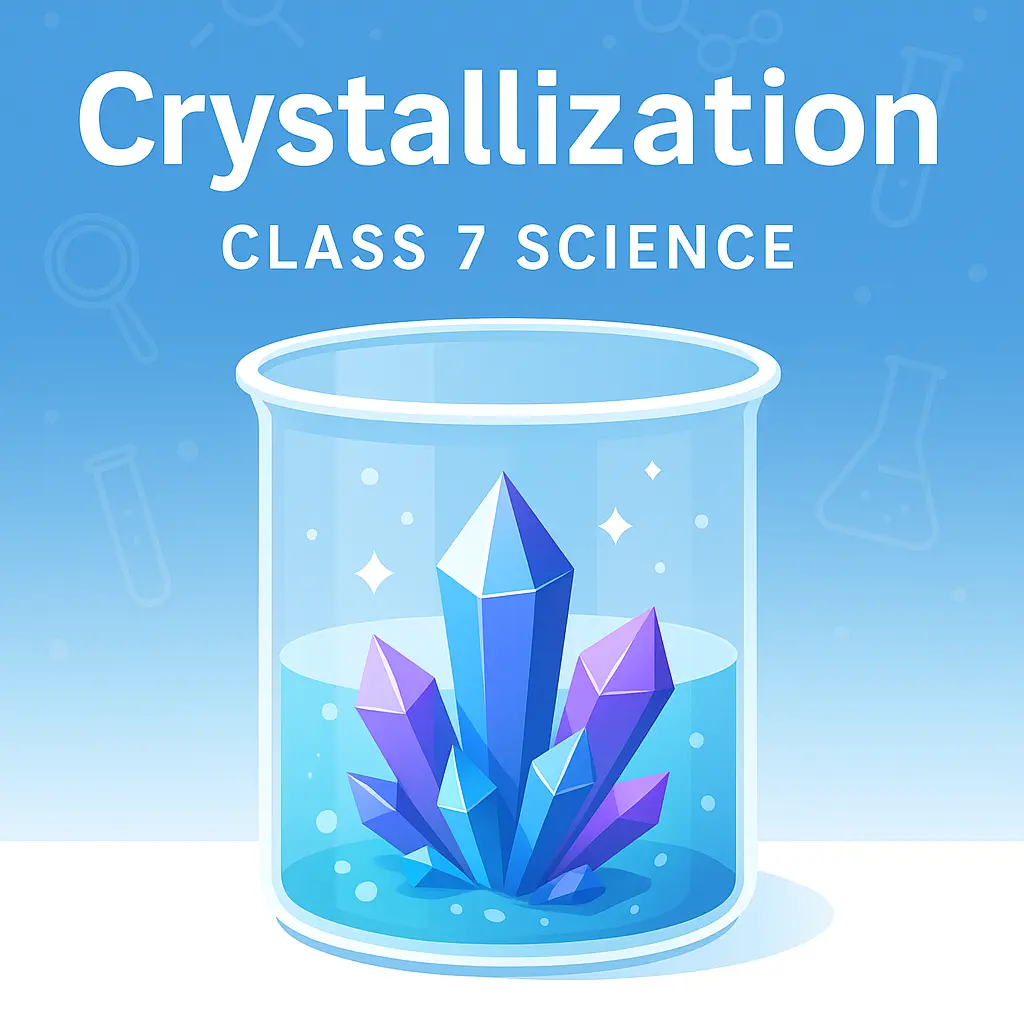Let’s understand what is crystallization and dive deep into it
What is Crystallization? | Class 7 Science Explained in Detail
Crystallization is one of the most fascinating processes in chemistry and daily life. For students of Class 7, understanding crystallization is essential because it not only appears in science exams but also helps build a deeper understanding of how substances change form. In this blog post, we’ll dive deep into what is crystallization, its steps, importance, and real-life examples — all in an easy-to-understand way.
What is Crystallization? (Class 7 Science Definition)
Crystallization is a physical process through which a solid forms from a solution or a melt, and takes a definite geometrical shape called a crystal.
In simpler terms, crystallization is the process of forming solid crystals from a homogeneous solution. It is a technique used to purify solid substances.

How Does Crystallization Work?
Crystallization typically involves two main steps:
- Making a saturated solution
- Allowing it to cool slowly
When the hot, saturated solution cools down, the dissolved substance can no longer remain in the solution and starts to form crystals.
Example:
When you dissolve salt in hot water and allow it to cool slowly, you’ll observe salt crystals forming at the bottom.
Steps of the Crystallization Process
Here’s a simple step-by-step process to understand how crystallization works:
Step 1: Choose a Soluble Substance
Example: Copper sulfate, sugar, salt
Step 2: Dissolve it in Water
Heat water and add the substance until no more dissolves (saturated solution)
Step 3: Filter the Solution
To remove impurities or undissolved particles
Step 4: Allow the Solution to Cool Slowly
Crystals begin to form as the temperature decreases
Step 5: Collect and Dry the Crystals
Once crystals form, they can be collected and dried
Why is Crystallization Important?
Crystallization is used for several purposes in science and industry:
- Purification of solids (e.g., sugar, salt)
- Manufacturing of medicines and chemicals
- Formation of minerals in nature
- Studying chemical structures
Real-Life Examples of Crystallization
- Salt from seawater: When seawater evaporates, salt crystals form.
- Rock candy: Made by crystallizing sugar from a solution.
- Crystals in caves: Naturally formed from mineral-rich water.
- Frost formation: Ice crystals forming on windows.
Types of Crystallization
1. Cooling Crystallization
Crystals form when a hot saturated solution is cooled slowly.
2. Evaporative Crystallization
Solvent evaporates, leaving behind crystals (e.g., salt from seawater).
3. Melt Crystallization
Used in industries to purify substances through controlled melting and cooling.
Topics covered:
- crystallization for class 7 students
- steps involved in crystallization process
- real life examples of crystallization
- importance of crystallization in daily life
- how does crystallization work
Difference Between Crystallization and Evaporation
| Feature | Crystallization | Evaporation |
|---|---|---|
| Purpose | Purification | Removal of solvent |
| Final product | Pure crystals | May not be pure |
| Appearance | Shiny, geometric crystals | Solid residue |
| Time taken | Slower process | Faster process |
Crystallization Experiment for Class 7
Materials Needed:
- Beaker
- Copper sulfate powder
- Water
- Spoon
- Heat source
- Filter paper
Procedure:
- Heat 100 ml of water in a beaker.
- Add copper sulfate slowly while stirring until no more dissolves.
- Filter the solution to remove impurities.
- Allow it to cool undisturbed.
- Observe crystal formation.
Observation:
Beautiful blue copper sulfate crystals will form.
FAQs About Crystallization
Q1: What is crystallization?
Answer: Crystallization is the process of forming solid crystals from a solution or melt.
Q2: Why is crystallization better than evaporation?
Answer: Crystallization gives pure, shiny crystals, whereas evaporation may leave impurities.
Q3: What are some examples of crystallization?
Answer: Salt from seawater, sugar crystals, and natural mineral formations.
Q4: Is crystallization a physical or chemical change?
Answer: Crystallization is a physical change because no new substance is formed.
Q5: What are crystals?
Answer: Crystals are solid substances with a regular, repeating internal structure and shape.
Summary
Crystallization is a vital process in both science and everyday life. Whether it’s purifying chemicals, growing crystals for fun, or studying mineral formation in nature, the concept of crystallization is deeply useful. For Class 7 students, understanding this concept lays the foundation for more advanced chemistry in the future.
Conclusion
We hope this guide helped you understand what crystallization is in Class 7 science. If you found it useful, share it with your classmates and teachers!
